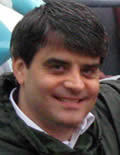
John Gagliardi left his office door open while he studied game film, an unheard of security breach compared to the paranoid lockdown of most college football programs. It’s true that Gagliardi, the head coach at Division III Saint John’s University in Collegeville, Minnesota, for 60 years until his retirement last Monday, Nov. 19, operated outside the scope of the sport’s most intense surveillance. Still.
Nobody has ever won more games. An accomplishment like that usually attracts copycats, but Gagliardi, 86, never had to worry about protecting his intellectual property. If any coaches sniffed around his office looking for insight or inspiration, none of them ever put his methods to use.
Football practices at Saint John’s were more like summer camp, maybe easier — if the gnats or mosquitoes got to be too much, Gagliardi called it off. His defining philosophy: no.
No calisthenics. No blocking, tackling or conditioning drills. No whistles.
Also: no cuts. Anybody who came out for the team made it, pushing the Saint John’s roster up toward 200 players some years.
No problem. Gagliardi ruled this affront to order and orthodoxy in an informal but steadfast way, producing team after disciplined team — winning 489 games and four national titles—despite relinquishing the suffocating control so many coaches exert.
Before his 2006 College Football Hall of Fame induction, I walked through Gagliardi’s open door in Collegeville, Minnesota, to learn about how he did it. He was watching film from the previous season with his son, Jim, the offensive coordinator.
They focused on Saint John’s offensive plays of eight yards or more because Gagliardi only cared about what worked and discarded what didn’t. “They say, ‘Eliminate the unnecessary,’” he said, “and we’ve found out a hell of a lot of things are unnecessary.”
By way of illustration, Gagliardi grabbed a commemorative football from the shelf and batted it at me. I caught it. “Who in the hell can’t do that?” he said.
That was his explanation for no tip drills, the ubiquitous training method to develop the reflexes and concentration to catch loose balls wobbling though the air. Gagliardi took it for granted that his players could do that, just like he expected them to be able to keep their balance without high stepping through ropes or tires in practice.
Without those (to him) pointless impositions, practices never lasted more than 90 minutes, whittled down to, essentially, playing the angles. “Don’t take any scenic routes,” he often said. To the exclusion of almost everything else, Gagliardi taught positioning and discipline.
He cued up a goal-line defensive play on his flat-screen television. After faking a handoff, the opposing quarterback sprinted to his left toward the end zone. Gagliardi aimed his laser pointer at a St. John’s cornerback at that end of the line of scrimmage. “This whole play depends on this guy being faked out.” He wasn’t. They’d spent a lot of time instilling that self-control in practice, preventing the sort of impulsive mental lapse which loses college games.
Yet even with a 147-34 record in his last 15 seasons, Gagliardi retires as more of an eccentric than a trendsetter, celebrated for his success, appreciated as an original, but dismissed as a model. Maybe his methods wouldn’t work at a higher level. They certainly would be a tougher sell in an atmosphere where the expectation to conform might be even greater than the pressure to win. Still.
Gagliardi’s accomplishments merit a closer look. He might not have changed the game, but he won more than anybody else in a career that stands as college football’s finest example of what not to do.
Jason Kelly, a former sports columnist for the South Bend Tribune, is an associate editor of the University of Chicago Magazine. His most recent book is Shelby’s Folly: Jack Dempsey, Doc Kearns, and the Shakedown of a Montana Boomtown. Email him at jasonkelly545@gmail.com.